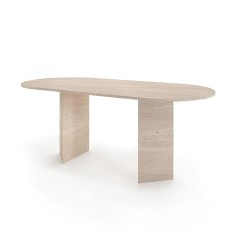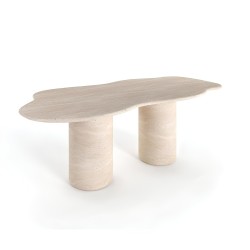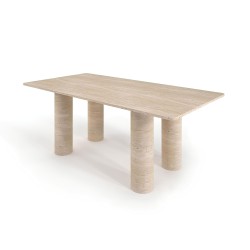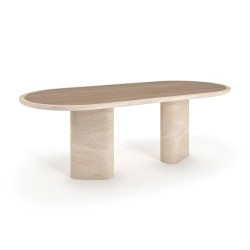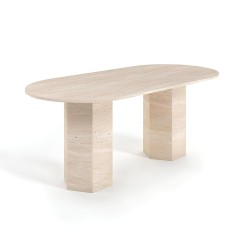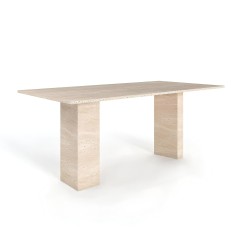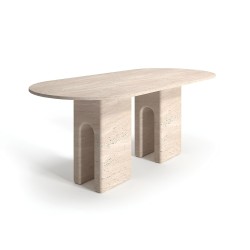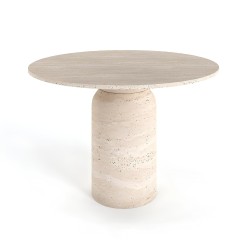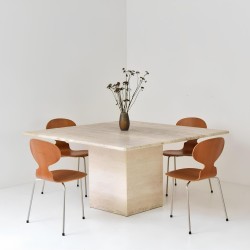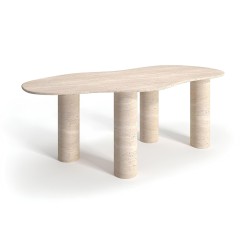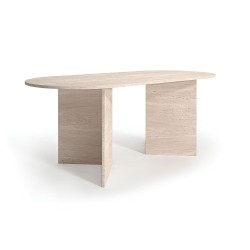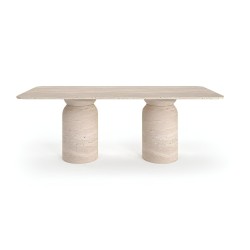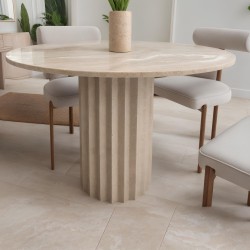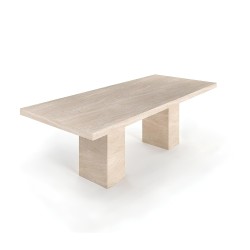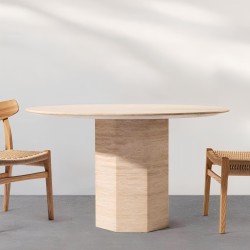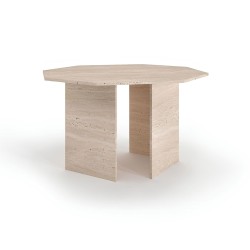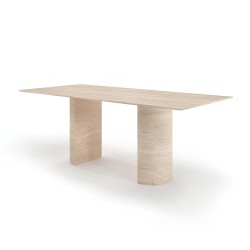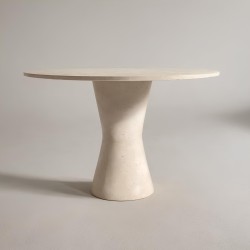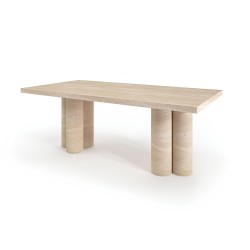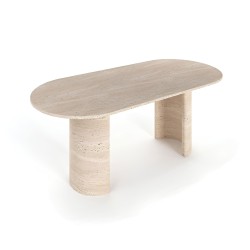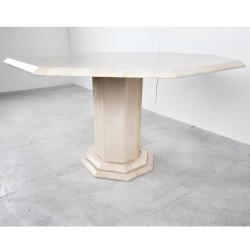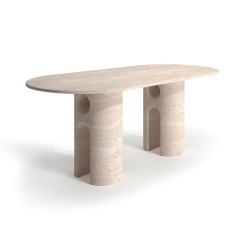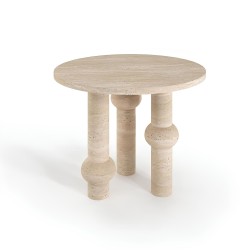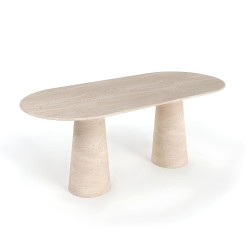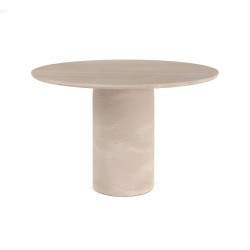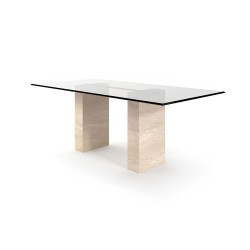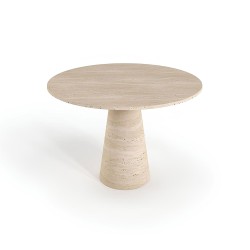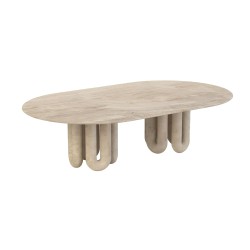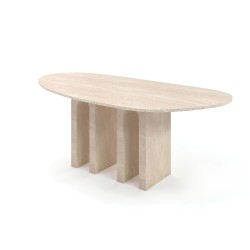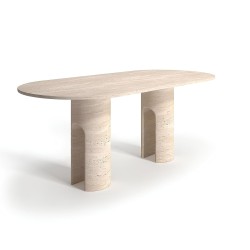Travertine Dining Table Модели
Travertine Dining Table
Travertine Dining Table: Bringing the Elegance and
Durability of Nature to Your Table
A travertine dining table is a remarkable piece of
furniture that combines the elegance and durability of natural stone with the
functionality of everyday use. Travertine is a type of limestone that forms
through the precipitation of calcium carbonate, typically in hot springs. Over
millions of years, this process creates a stone that is both porous and
durable, making it an excellent choice for dining tables. Each piece of
travertine has unique patterns, textures, and colors, ensuring that every travertine
dining table is one of a kind and adds a distinct aesthetic value to your
dining space.
The Origins and Characteristics of Travertine
Travertine is predominantly found in countries like Italy,
Turkey, Iran, and Mexico. These regions have extensive natural quarries where
travertine is extracted in large blocks. The stone has been used in
construction and decoration since ancient times, especially in Mediterranean
architecture. Its versatility allows it to be used both indoors and outdoors,
making it a favorite material in various design contexts.
One of the most striking features of travertine is its wide
range of colors and textures. The stone can be found in shades of beige, cream,
brown, gray, and even red, offering a broad palette for designers and
homeowners. This diversity in color and texture means that each travertine
dining table is unique, with its own set of patterns and veining that
reflect the stone's natural formation processes. These natural variations
ensure that no two travertine dining tables are exactly alike, making each
table a distinctive piece of art in its own right.
The Aesthetic and Functional Value of Travertine Dining
Tables
A travertine dining table is not only a visually
stunning addition to any home but also offers significant functional benefits.
The natural texture of travertine adds warmth and a welcoming atmosphere to any
dining room. The stone's surface features small pits and holes that are
characteristic of its porous nature. These natural imperfections add to the
stone's charm and contribute to the unique look of each travertine dining
table.
The porous nature of travertine also means that the table's
surface has a slight texture, which can help prevent items from slipping.
Additionally, travertine is naturally resistant to heat, allowing hot dishes
and pots to be placed directly on the table without causing damage. This makes
the travertine dining table not only beautiful but also practical for
everyday use.
The Production Process: From Quarry to Dining Room
The journey of a travertine dining table begins in
natural stone quarries, where large blocks of travertine are extracted. These
blocks are then transported to factories, where they are cut into slabs of
various thicknesses and sizes. The slabs undergo several processes to achieve
the desired finish, including polishing, honing, and filling. Polishing
enhances the stone's natural shine, while honing provides a matte finish that
many find appealing. The filling process involves sealing the stone's natural
pores to create a smoother surface.
Some designers prefer to leave the travertine unfilled,
maintaining its rustic and natural appearance. This choice depends on the
desired aesthetic and the table's intended use. The travertine slabs are then
cut into the appropriate shapes and sizes for the table's top and legs. These
pieces are assembled, often with metal or wood bases, to create a cohesive and
aesthetically pleasing piece of furniture. The combination of materials, such
as metal or wood with travertine, adds to the table's overall visual appeal and
ensures its structural integrity.
The Advantages of Travertine Dining Tables
There are numerous reasons why a travertine dining table
is an excellent choice for your home. One of the most significant advantages is
the natural beauty and uniqueness of each table. The variety of colors,
patterns, and textures available in travertine means that every table is a
one-of-a-kind piece that adds character to your dining room.
Another major advantage of travertine is its durability.
Over time, travertine can develop a patina that enhances its appearance, giving
the table a timeless quality. With proper care, a travertine dining table
can last for many years, making it a worthwhile investment. The stone's
resistance to heat also makes it practical for everyday use, as you can place
hot dishes directly on the table without worrying about damage.
Caring for Your Travertine Dining Table
Given its porous nature, travertine requires proper care to
maintain its beauty and longevity. Regular maintenance is essential to ensure
that your travertine dining table remains in excellent condition. One of
the most important steps in caring for travertine is sealing the surface
regularly. Sealing helps to close the stone's pores, preventing liquids and
stains from penetrating the surface. This process is crucial in maintaining the
table's appearance and preventing long-term damage.
When it comes to cleaning, it is important to use
pH-balanced, gentle cleaning products. Acidic cleaners can damage the stone and
cause discoloration. Therefore, it is advisable to clean your travertine
dining table with products specifically designed for natural stone.
Additionally, any spills should be wiped up immediately to prevent staining. By
following these care tips, you can ensure that your table remains beautiful and
functional for years to come.
Bringing Nature Indoors with a Travertine Dining Table
A travertine dining table is more than just a piece
of furniture; it is a statement piece that can transform the atmosphere of your
home. The natural warmth and elegance of travertine bring a touch of the
outdoors into your dining room, creating a serene and sophisticated
environment. The stone's unique texture and color variations add a sense of
depth and character to the space, making your dining area both inviting and
visually appealing.
Travertine dining tables are particularly well-suited for
homes with natural or rustic decor. When paired with materials like wood,
leather, or linen, the warmth and elegance of travertine are further enhanced.
This combination of natural elements creates a harmonious and aesthetically
pleasing environment, adding both visual interest and comfort to your dining
space. For those seeking a sophisticated and timeless look, a travertine
dining table is an ideal choice.
Conclusion: Elevate Your Dining Experience with a
Travertine Dining Table
A travertine dining table offers a unique blend of
natural beauty and durability, making it a standout addition to any home. Its
distinctive texture, wide range of colors, and inherent strength make it a
versatile and long-lasting investment. With the right care, a travertine dining
table can enhance your dining space for many years, bringing a touch of
nature’s elegance into your everyday life.




























